Released October 13, 2021
Driving the Newest Ariel Atom 4 powered by the Honda Civic Type R 2.0L Turbo Engine making 350hp. It weighs in at 1350lbs so the power to weight ratio rivals heavy hitter supercars.
Released October 13, 2021
Driving the Newest Ariel Atom 4 powered by the Honda Civic Type R 2.0L Turbo Engine making 350hp. It weighs in at 1350lbs so the power to weight ratio rivals heavy hitter supercars.
Released July 13, 2021
Auto scribe Zack Klapman and pro racer Dai Yoshihara get behind the wheel of the all-new Ariel Atom 4.
Loaded with the powertrain of a Honda Civic Type R but weighing just 1,350 pounds, Zack and Dai find out if the street-legal, bare-bones sports car is as fast and fantastic as it looks.
SavageGeese at it again with the Ariel Atom 4 | $75,000 Bucket List Car
We review the brand new Ariel Atom 4, a huge leap forward in refinement and fun. There are fewer cars in the world that deliver a pure driving experience and a manual transmission, this is one of the last. We cover how it's manufactured, the technical side, and much more. Whether you are in the UK or North America, the driving impressions on the street and track will help paint the picture. There are other cars like the Porsche 718, Mustang GT500, Corvette C8, and Lotus Evora in a similar price tag, which would you choose?
WHAT URGE MAKES middle-aged men want to slip the surly bonds of inertia in ever more minimalist machinery? I’m asking for a friend. The Ariel Atom 4—a skeletonized version of a mid-engine two-seater ($87,910, as tested)—belongs to a class of barely-there G-force generators that also includes sailplanes, parasails, ultra-lights, hang-gliders and hot-air balloons. You can’t tell me that’s not symbolic.
Why just men? No one can say. When I asked Mark Swain, president of TMI AutoTech, which builds the Ariel in Virginia under license from the UK-based founders, he only noted the clientele were “almost entirely male,” which made me giggle, but I took his point. The shop in Virginia is tooled up to make 50-70 Ariel Atom 4s per year, said Mr. Swain.
The machinery seems to vanish, leaving just the unscrolling of the road.
Introduced in 2000, the Atom became famous in a 2004 episode of Top Gear in which host Jeremy Clarkson’s face flaps in the wind like Air Force Colonel John Stapp’s on the rocket sled. Now that was good television. It also nicely illustrated the Atom’s unique transparency to the elements at speed.
No top, ever. There are two frameless windshields available, small and smaller. The reinforced-plastic seat is bolted to the floor. Looking over the Alcantara-wrapped steering wheel, the TFT display, and the cockpit switches, the driver sees, well, almost nothing—or everything, depending on one’s phenomenological status.
Holding up the car’s slender nose, the pushrod/inboard-coilover suspension and double wishbones do their kinematic thing practically at arm’s reach. Dancing at their ends are the hubs, wheels and wide tires, wearing small skull caps of fiberglass: The fenders.
These sight lines are fundamental to the Ariel’s magic. At times the machinery seems to vanish below the experiential horizon, leaving just the driver, the sound, and moment-by-moment unscrolling of the road. This is the view of an angel flying at zero altitude just before he gets thrown in jail in Virginia.
The Ariel’s other secret is no secret. Anyone who has driven an open-wheel car knows how awesome, how empowering, how liberating it is to be able to see through the corners, over the squirming and squawking tires. It’s just science.
Outside of the Ariel, about the only way to scratch that itch is a single-seat race car, like Formula Ford. But that means hanging around in the paddock with people half your weight and a third your age. Besides, no other car has that gorgeous trellis of tubular steel through which the rushing tarmac and terrain can be seen, like, right there.
Another of the Ariel’s talking points is that—unlike motorcycles or even three-wheelers such as the Polaris Slingshot—it is exempt from state laws requiring helmets. That’s huge in terms of owners’ convenience, although it won’t do much for their hearing.
Speaking of helmets: Only a fraction of Ariel owners ever drive their cars on a racetrack, according to Mr. Swain. That’s surprising. With respect, why would anyone buy this ass-hammering mosquito and not track it, like, every weekend?
Last week, as part of its media day, the company belted me into the re-engineered Atom 4 to drive a few laps around Virginia International Raceway’s 1.1-mile Patriot Course. It was special. It might have been more special if I hadn’t had a 200-pound factory representative in the right seat, or if the car’s optional three-stage engine mapping (turbo boost) and seven-stage traction control had not both been set to “Assisted Living.”
I didn’t take it personally. Even a dialed-back and ballasted Atom 4 demands respect. Mounted just ahead of the rear axle and seemingly bolted to one’s vertebrae, the exquisite 2.0-liter Honda turbo-four puts out up to 350 hp at 7,000 rpm and 310 lb-ft, channeled through a six-speed manual gearbox. These ponies are pitted against a mass of only 1,350 pounds, giving the Atom 4 roughly the power-to-weight ratio of a McLaren F1.
Point this little erector set straight, unload the clutch pedal in 2nd gear, and hang on. The Atom 4 will clap you between the shoulders, swirl your eyeballs and smother your reason with the shrill shimmer of turbosuck and a bypass valve that sounds like your right ear is being blown out of an airlock—bu-WHISHHH!
Under ideal conditions, and with adroit shifting, the Atom 4 can hyperventilate its way to 100 mph in 6.8 seconds on its way to a top speed of 162 mph.
Some glad morning, if I win the lotto, I’ll fly away.
-Dan Neil, Wall Street Journal, Automotive Editor
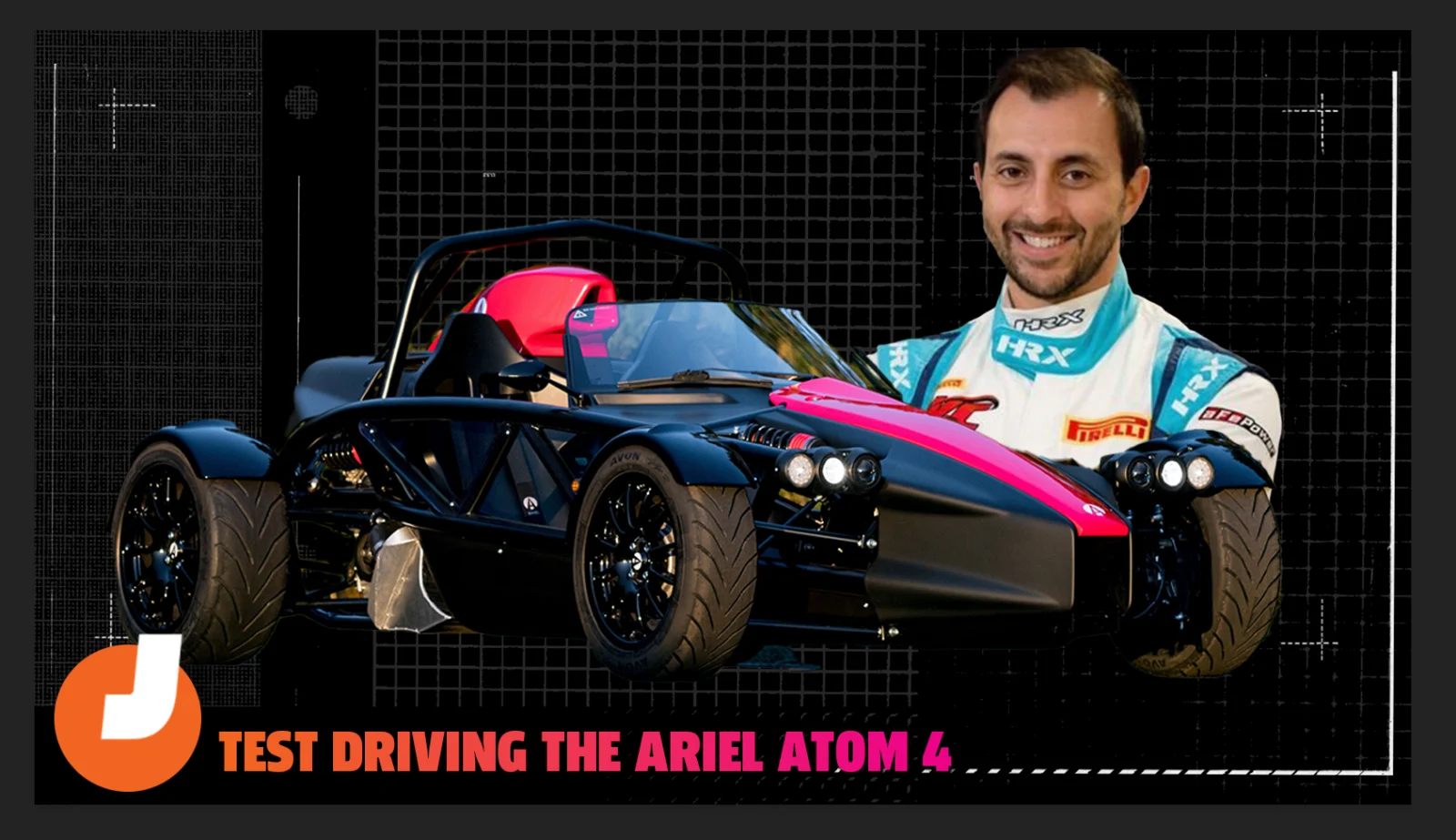
A great track based writeup on the new Atom 4 from Jalopnik
Check out what Travis Okulski had to say about the new Ariel Atom 4

BorgWarner transformed an Ariel Nomad into comprehensive electrified demonstration vehicle
Vehicle showcases BorgWarner’s complete electric propulsion system capabilities
Company’s new ride helps expedite research, development and validation processes for implementing new technologies
Auburn Hills, Michigan, October 25, 2019 – BorgWarner, a leader in advanced propulsion systems, is proving its electrification expertise with the development of its Corporate Advanced Engineering (CAE) group’s first high-voltage, all electric demonstration vehicle. The new test platform, created from the all-terrain Ariel Nomad, gives its engineering team and customers a comprehensive view of BorgWarner’s technologies as well as their performance. The technologies highlighted on the vehicle include traction inverters, a torque-vectoring rear drive unit, an electric coolant pump, vehicle and traction control software, a DC/DC converter and a high-voltage battery pack, magnifying the company’s product leadership and ability to deliver an entirely electric propulsion system.
“Our new high-voltage demonstration vehicle illustrates BorgWarner’s leadership in electrification and gives us a fantastic tool to showcase our extensive capabilities, collaborate with industry partners and evaluate BorgWarner’s current and future technology at a system-level,” said Hakan Yilmaz, Vice President and Chief Technology Officer, BorgWarner Inc. “We will continue to embrace projects such as this EV demonstration vehicle that help us validate next-generation products and, ultimately, propel the industry toward a cleaner, more energy-efficient world.”
A benefit of the vehicle’s electrified powertrain is its improved steering response made possible through torque vectoring. This feature allows both forward motion and regenerative braking, delivering a dynamic and controllable driving experience. Another key technology is BorgWarner’s thermal-management system, which circulates coolant via an electric pump through the inverters and battery pack. The liquid-cooled, 350V 30kWh pack delivers peak power of 200kW.
Beyond the significant propulsion technologies that make up the vehicle, BorgWarner’s CAE group was able to build its demo vehicle in just six months. Part of the reason the Ariel Nomad was chosen as the base vehicle for this demonstration project was the ease of access to install and remove components due to the open-air design of the vehicle.
The vehicle also is a proving ground for BorgWarner’s partner companies. Cascadia Motion, a BorgWarner-owned company, developed the rear-wheel-drive system featuring two separate BorgWarner High-voltage Hairpin (HVH) 250 electric motors and eGearDrive gear sets, each one independently controlling a rear wheel. This system, also featuring two of BorgWarner’s inverters, gives complete authority over the vehicle and enables more power and durability.
In addition, BorgWarner’s joint venture with Romeo Power, a leading-technology battery pack and module supplier, allows BorgWarner to power the demonstration vehicle with different configurations of battery power, and test and validate particular battery pack applications for specific vehicle goals or driving experiences. The joint venture’s battery modules and packs are expected to include intelligent battery management systems with proprietary algorithms for enhanced performance and cycle life, as well as proprietary thermal engineering for active and passive cooling.
The speedy and proficient evolution of the demonstration vehicle exemplifies BorgWarner’s competence in rapidly implementing new technologies for future projects – a timeline that will steadily get faster through the use of this new, powerful demo vehicle.
As a continuation of our Motorsports offerings, we are excited to announce the all new Ariel Atom - Track Attack, a packaged model focused toward Track Day patrons. The Track Attack is equipped with features that add functionality and convenience to your dedicated Track Car.
Included as Standard/No-Cost options with the Track Attack:
The Track Attack also allows for customization of the vehicle build to make it truly yours. Choose a custom chassis color and from our selection of Premium Paint Colors at no additional cost!
Mark Swain, President of TMI AutoTech (the North American home for Ariel), was featured in SavageGeese's latest "The Joy of Driving" series.
See how Mark got his start in the Automotive field, and what advice he has for others looking to do the same:
Ariel Motor Company announces the launch of the latest evolution of the Ariel Atom, now in its fourth generation, the all-new Atom 4.

Designed by the in-house Ariel team, the Atom 4 continues the now iconic design but is an entirely new car from the ground-up. Building on the learning from previous generations, customer feedback, Ariel assembly technicians and significant R&D by Ariel in recent years, the Atom 4 preserves the essential Ariel qualities but progresses the design and engineering further into the most powerful and able Atom yet.
Atom 4 features the latest Honda Type R turbo engine giving 320bhp as standard, all-new chassis, suspension, steering and brakes, all-new bodywork with significant aerodynamic improvements, new seating and instrumentation together with a host of design improvements and changes. With an open design brief to improve the car wherever possible, the Atom 4 represents another big step forward in the evolution of the Atom.
Said Simon Saunders, Director of Ariel: “The Atom 4 is the biggest change to the car since we originally released it in 1999. It really is an all-new car; in fact, there are only three parts carried over from the last Atom – the clutch/brake pedals and the fuel cap.”
Atom 4 will continue to be made in low volume by Ariel at its factory near Crewkerne, Somerset in quantities of around 100 cars per year alongside the Ariel Nomad and Ariel Ace motorbike.
Each car will be built, as they are now, by one technician and to order for each individual customer. Having earned its reputation as the ‘Savile Row of the Automotive World’ Ariel has a tailor-made approach to building vehicles that isn’t possible at high volume and reflects the opportunities achievable only in low volume production. Atom 4 will also be made, under license, by Ariel North America based in South Boston, Virginia serving North and South American markets. The cars will have identical specifications, combining the best high and low volume engineering, materials, and production values together with an option list and bespoke build system that gives each customer exactly the car they need. From fun sports car to track weapon, the Atom 4 will deliver.
The car will also be the first Ariel vehicle to undergo full European Small Series Type Approval (ESSTA) and ADR (Australian Design Rules) testing, to enable Atom 4 to be sold throughout Europe and Australasia with a Certificate of Conformity from 2019. Said Tom Siebert, Director of Ariel Motor Company: ‘Though we have had a small European presence over the years, there is an enormous demand for our vehicles in this market and elsewhere in the world. British-built, low volume vehicles appeal on many different levels and Type Approval is key to our future commitment to service those markets effectively. As well as our existing network of dealers, we will appoint new key agents in various countries, to make sure that as many potential customers have access to Atom 4 as possible’.
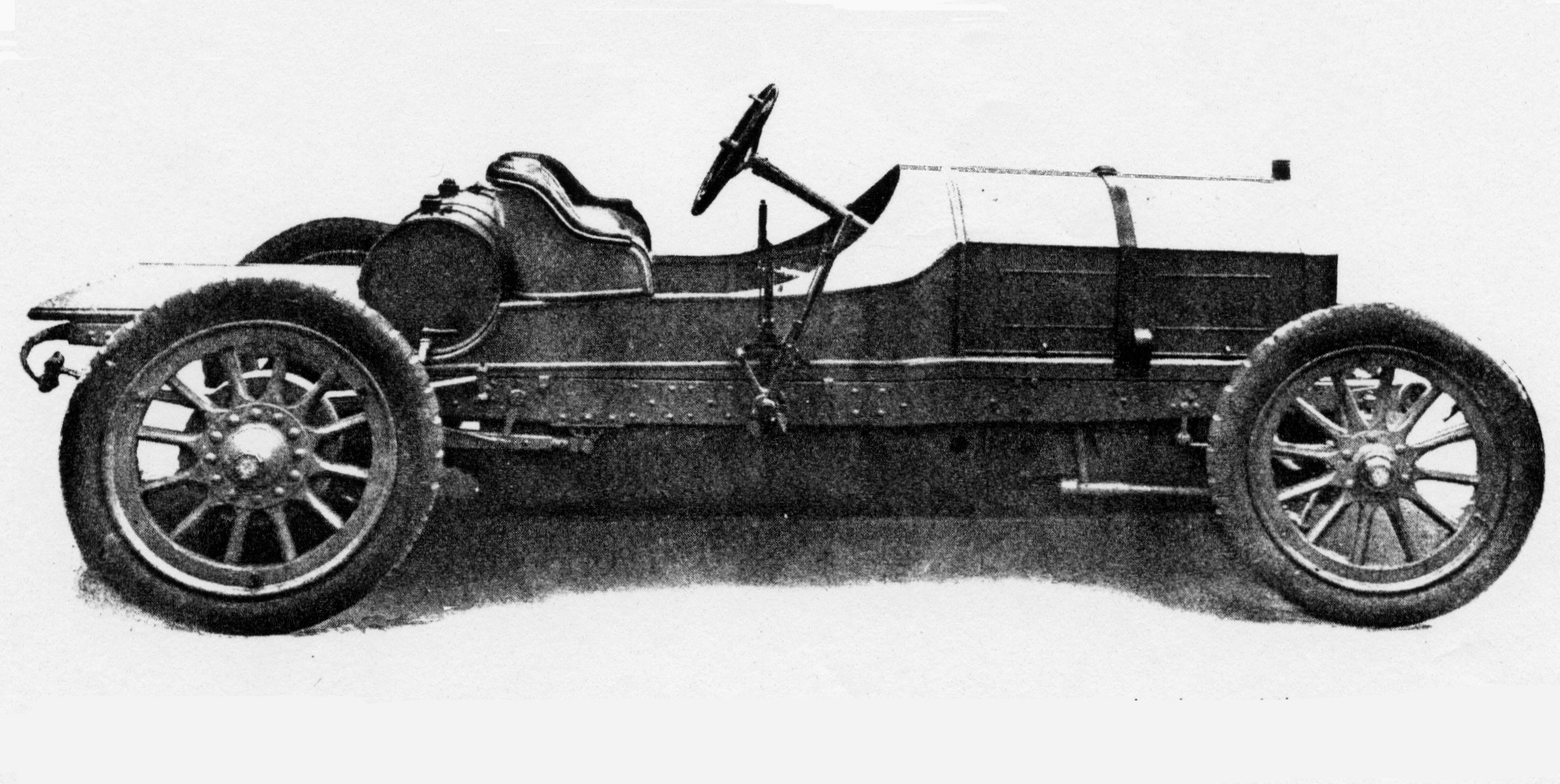
As one of the very oldest names in automotive history, Ariel was started in 1870 by James Starley, also inventor of the differential and rack-and-pinion steering, with an Ordinary (Penny-Farthing) bicycle. As the first steel-framed production bicycle, the Ariel also featured steering and patented spoked wheels, revolutionizing the early transport industry. With the rapid development of vehicles in the 1890s and early 1900s, Ariel advanced through De Dion-engined tricycles and Quadricycles as well as motorcycles in a fast-changing industry. As a manufacturer of early Grand Prix cars, Ariel was an entrant in the first-ever race at Brooklands in 1907, winning at the second event the following weekend. From the late 1900s, the company centered its attention on motorcycle production with occasional excursions into 4 wheel vehicles. Best known for the ground-breaking Ariel Square 4, multiple International Six Day Trial winning HT5 and pressed steel frame Arrow, the company became one of the great names of the British motorcycle industry. Ariel was revived in 1999 with the launch of the Ariel Atom, featuring the now famous exposed spaceframe powered by a Rover K Series engine. A major redesign in 2003 included the introduction of the Honda K20A Type R engine and saw the start of Ariel’s relationship with Honda, which continued into the Ariel Ace motorbike and Ariel Nomad. A constant development of the car saw the Atom 3 introduced in 2007, with the Honda K20Z Type R engine, and the Atom 3.5 in 2013 with revised chassis and suspension. Over 1800 Ariel Atoms have been made since the first production cars were delivered in 2000, making Atom ownership an exclusive but growing club. As a forward-thinking company, Ariel will continue to evolve the Atom, but the soul of the Atom will always be attainable, rewarding performance and sheer driving pleasure.

The basis of Atom 4 is an all-new tubular chassis, designed in-house by the Ariel engineering and design team, with much learning coming from the Titanium Chassis R&D project of 2014. Featuring larger diameter main and diagonal tubes than previous Atoms, as well as many detailed additions, each tube within the chassis has been analyzed and optimized to give a light but extraordinarily strong structure. The torsional stiffness has been increased by 15% compared to the previous generation Atom 3.5.
The combination of sophisticated CAD (Computer Aided Design) and FEA (Finite Element Analysis) design work resulting in a hand-made, bronze welded structure reflects Ariel’s approach to design and manufacture, combining new technology with exceptional craftsmanship.
Said Tom Ward, Ariel’s Chief Engineer: “Redesigning an icon can be quite intimidating and doing this with increasingly strict legislation plus Type Approval in mind is a big task for a small company like ours. Our growing design and engineering team forms 25% of the Ariel workforce so we are committed to making Ariel absolute leaders in their field.”
The chassis gives more interior space and legroom than previously and has been designed and proven to well exceed the demands of a full frontal 50kph barrier impact, seat belt, and rear impact test. Forming a driver/passenger safety cell the Atom chassis offers the highest degree of protection in its class. Chassis are treated to a three-stage finishing process of phosphating, powder coating to color choice and powder coating lacquer.

At the heart of the Atom 4 is the new Honda Type R K20C 2.0L 4 cylinder direct injection, turbocharged engine. Building on the 15-year relationship with Honda UK with Honda power in Atom 2, Atom 3 and Ariel Ace motorcycles, Ariel has signed a new agreement for engine supply with Honda. Said Simon Saunders: “The Honda agreement is critical for us and our customers. The Type R engines have proven themselves in Atoms over the years with dependable power and absolutely faultless reliability, even under race conditions, so there really is no better engine for the Atom.”
The 1996cc direct injection turbocharged engine, producing 320bhp as standard in the Atom – 10bhp more than the previous supercharged Atom – gives the Atom 4 more power than any previous standard model. An astonishing 420Nm of torque is a massive 75% increase over a standard Atom 3.5 and a 35% increase over a supercharged Atom 3.5.
Mapped by Ariel using an MBE ECU (Electronic Control Unit) developed specifically for the car will allow the Atom 4 to meet Euro Vl emissions standards, a critical factor of the EUSSTA testing. Optional Launch and Traction Control is a new feature built into the electronics of Atom 4, derived from the Atom V8. Atom 4 also features the ability to adjust and optimize turbo boost levels for different road and track conditions.
An all-new exhaust system, again designed to meet EUSSTA standards as well as racetrack noise levels, features a ceramic honeycomb, high palladium/rhodium content catalytic converter, 3”/75mm diameter stainless system into a twin outlet, 8.4”/215mm stainless silencer. A high flow single outlet system is an option as is a de-cat system for use on the track.
A larger capacity fuel tank sits on the left-hand side of the car, improving range on road and on track, giving a road range of some 300 miles.
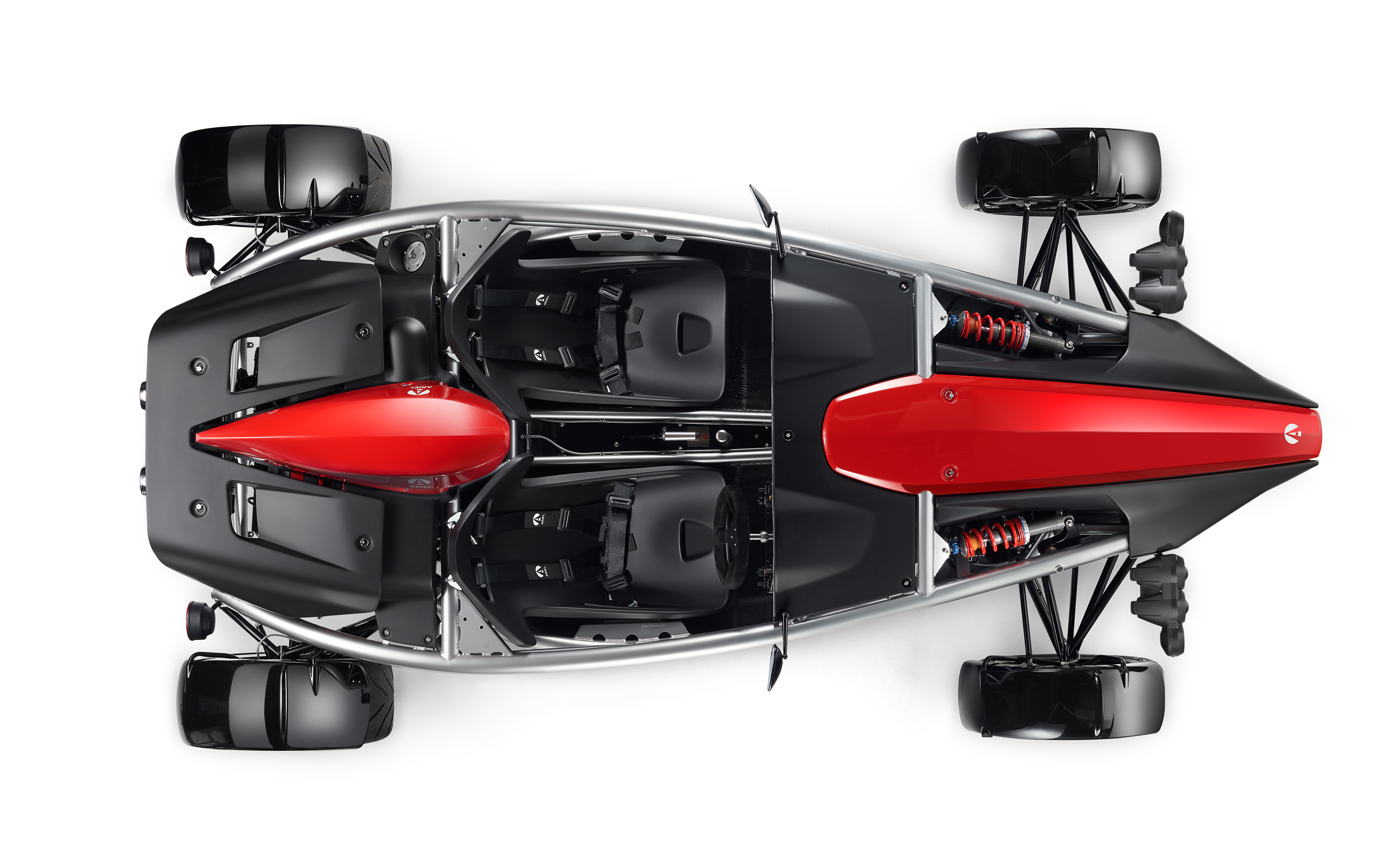
Retaining the inboard, pushrod operated damper system the Atom 4 features all new suspension geometry. Based on 18 years of continual development from Ariel and design input from suspension guru Richard Hurdwell, the new geometry includes revised inboard and outboard points plus anti-squat and anti-dive to reduce unnecessary body roll and weight transfer, keeping as much tire contact as possible at all times. All new Bilstein dampers sit inboard operated by pushrods via new geometry bellcranks, with an optional semi-active Ohlins package under development for production.
Revised steering rack and geometry give the new Atom accessibility for all types of drivers under all driving conditions, with the option of a quick rack for track-focussed cars. “It’s important that the Atom not only handles superbly but has ultimate driveability,” said Sam Evans, engineer in charge of Atom suspension development. “On Atom 4 we have gone to enormous lengths to ensure the car is as easy to drive on the road as it is fast on a race track.”
An improved turning circle has also been achieved with the new suspension and steering rack geometry to aid town driving and parking.

Moving up in size the Atom 4 sits on 7Jx16” front wheels and 9Jx17” rear wheels. Multi-spoke alloy wheels are standard fitment but, in a first for Ariel, the Atom 4 has the option of full carbon wheels. These represent a weight saving of nearly 50% over an alloy wheel and a total reduction of over 16 kilos. The wheels, made to Ariel specification by BST in Johannesburg (who also make the carbon wheels for the Ariel Ace), significantly reduce unsprung weight together with new aluminum uprights, which alone give a 50% weight saving over the previous car.
Tires are 195/50R16 front and 255/40ZR17 rear. In a new exclusive partnership with Avon Tyres, the Atom will be fitted with high-performance Avon ZZR tires. With recent changes in tire law and noise, it is important that the highest performing tires are available to the Atom. The combination of new suspension and larger section Avon tires contribute to the Atom 4 having more mechanical grip than any previous Atom. Not only is straight line performance improved for the Atom 4 but cornering speed moves to another level also.

The all-new standard braking system increases in size, due to the higher power of Atom 4, with 278mm vented discs and cast two-piston caliper on the front with 253mm discs on the rear and integrated handbrake caliper. An optional upgrade is to a full AP Racing configuration of 290mm vented discs front and rear with alloy 4 piston calipers. A variety of brake pads are available dependent on the use of the car. An all-aluminum pedal box with brake, clutch and throttle pedal is supplemented by the optional cockpit adjustable brake bias. Goodridge stainless hose for both brake and clutch hydraulic systems is standard fitment.

The Atom 4 features an all-new look and while recognizably an Atom, every panel on the car is new. One of the fundamental design principles on Atom 4 was aerodynamic improvement, control of airflow and overall balance of the car. Working in partnership with TotalSim, CFD (Computational Fluid Dynamics) experts in Brackley, and in keeping with the original Ariel ‘Form Follows Function’ philosophy, major aerodynamic improvements have been made in every area of the car. Drag has been reduced, downforce increased and mass flow rate to radiator, intercooler and air intakes greatly increased. A shift in aero-balance has been achieved to give neutral handling and more precise control at the limit.
Immediately noticeable is the disappearance of the familiar central Atom roll hoop, now enclosed under the air intake bodywork, which itself has been reduced in size. This has greatly improved air passing over the rear bodywork and controls airspeed going through the ram-air system. Similarly, the new nose cone has smaller openings and internal ducting to reduce drag and decelerate airspeed, maximizing efficiency through the front mounted radiator. The intercooler mounted behind the tub, in a low-pressure area, keeps the unit close to the engine and is also supplied with air from under the car, optimizing cooling efficiency.

The trademark Atom ‘aero screen’ has been further refined and now reaches all the way across the car, reducing ‘helmet lift’ for the occupants, directing air to the engine intake and, with just this aero fence, generating 100 Newtons of downforce. The mudguards on all four wheels also feature an aero device to give downforce directly to tires negating any lift from mudguards.
Ralph Tayler-Webb, Chief Designer at Ariel said: “The aerodynamics on the Atom 4 have been an epic journey with literally hundreds, if not thousands, of iterations backwards and forwards between us and TotalSim. Keeping the Atom true to its roots but making such big strides with the aero has been a long haul, but it has paid off. Atom 4 is a highly-sophisticated design that has improved the performance in many different ways and on a number of levels.”
Bodywork will be available in full carbon for many of the body parts, reinforcing the ‘Less = More’ Ariel philosophy of performance through lightweight.

All exterior lighting has been revised with LED indicators, stop/tail/fog and reverse lights, daytime running lamps and high-performance halogen headlights to conform to EUSSTA regulations. Ambient light sensors allow auto light functionality.
Additional storage space has been included under the removable front body cover, extending the cubby box, together with access to the new hydraulic system. Individually adjustable single seats replace the twin seat unit of previous Atoms and a comprehensive study into ergonomics has subtly repositioned pedals, steering wheel, and instruments. Already a comfortable space for most drivers, an additional 50mm of cabin length and 20mm width has been added to accommodate the very widest range of users.
The new switch cluster, again designed to EUSSTA standards, features all controls within finger reach of the 310mm suede steering wheel including lighting, indicators, adjustable traction and launch controls. The central instruments, with full-color TFT (Thin-Film-Transistor) screen made for the Atom 4 by AIM, can be scrolled through multiple menus for the road, track or set up use. The instruments also have gear position and shift lights as standard plus provision for real-time race track data-logging. Using the AIM PDM (Power Distribution Management) system, communicating directly with the ECU via CAN (Controller Area Network), the vehicle wiring harness and fuse box have been simplified and therefore light-weighted.

Atom 4 is the fastest standard Atom produced so far. With the dramatic increase in torque, as well as 320bhp as standard, both standing start and in gear acceleration times are the fastest yet for a standard Atom: 0-60mph in 2.8 seconds, 0-100mph in 6.8 seconds retain the Atom’s giant-killing performance.
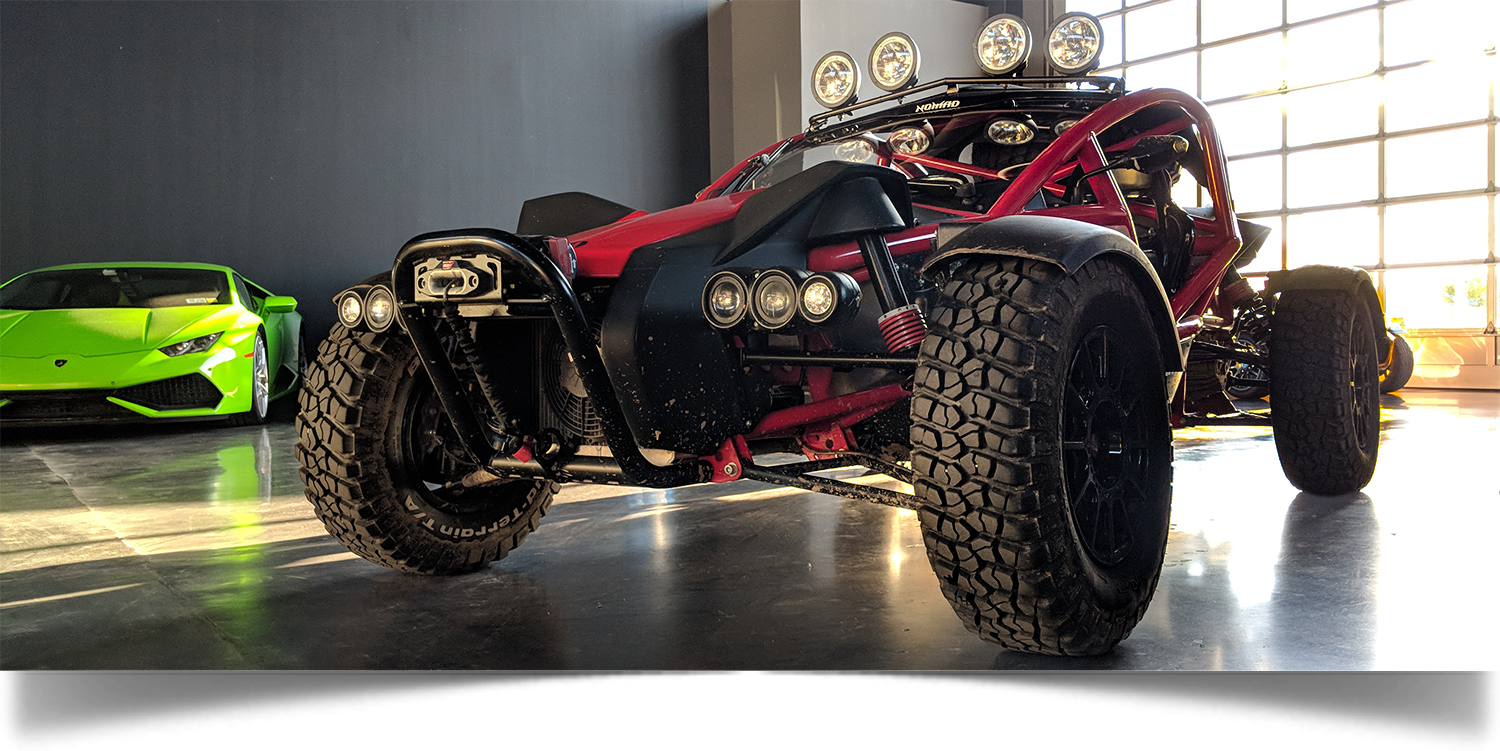
The Ariel Nomad fits oddly well within a metropolis environment. With its large tires, long travel suspension, and open cockpit design - what better vehicle to attack potholes/curbs/rubble and do some urban exploration...?
Our Nomad Tactical will be on display, with Classic Car Club Manhattan, from June, 15th - June, 20th. The private club is opening their doors for public viewings from 9 a.m. - 1 p.m. and into the evening for members.
Make sure catch the Nomad while it's in town! Click here for location details and check out New York City's best hangout spot for car enthusiasts:
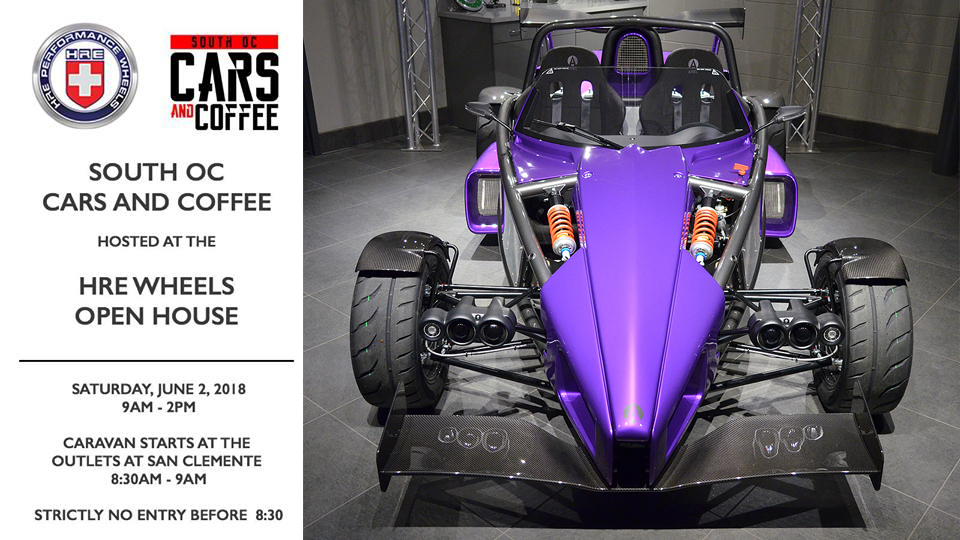
Forman MotorWorks will be attending South OC Cars & Coffee and the HRE Performance Wheels Open House on June 2nd . Forman will have an Atom 3S on display, contact us for full details or schedule a private viewing.
***From Forman Motorworks***
Quality of cars on a different level in Huntington Beach. 😳
Thanks Cars 'N Copters on the Coast for an amazing event.
***From Forman Motorworks***Look outside to see the jets. Stay inside to see the rocket!
One of only 10 limited edition Atom 3R 2.0L Supercharged models on display in the Ross Aviation Scottsdale FBO terminal this week.
Passing though in the near future? Contact us for an appointment at our Scottsdale office. We’d love to show you some of our exclusive new offerings.

***From Forman Motorworks***
Extraordinary turnout for the Mothers Exotic Car Paddock at the 2018 Toyota Grand Prix of Long Beach. One of our clients even got drawn for the raffle to make a parade lap around the track in his Atom before the race!
If you’re in Long Beach stop by and check out our newest Guards Red Atom 3S Turbo.
Andy Pilgrim and Automobile Magazine got their hands on the Ariel Atom 3S!
Excerpt from the article:
"The Ariel Atom 3S is a rather special vehicle. It certainly isn’t cheap, but I suspect the folks seriously looking at purchasing one aren’t worried about cost. The 3S is rewarding to drive at any speed and let’s not forget the incredible ear candy. I received more attention while driving it and more questions while parked than with any other vehicle I’ve driven; nothing even comes close. You buy a 3S because you want to have a ridiculously fun experience, which it provides in shovel loads. Expensive? No argument. Worth it? Heck yes."
Read the rest of the article and wacth the video here:
Check out one of our most recent completions. This Atom 3S is outfitted with a Guards Red Premium Color Package, Gloss Black Custom Chassis Color, Gloss Black Custom Wheel Color, Carbon Fiber Wings/Fenders/Dash Surround, Red Embroidered Seat Logos, and an LED Rain Light. Contact Us to discuss your Ariel Atom build.
The last year has brought the Ariel lineup to the forefront of many events, showings, and media. From adding the first dealer offerings in Florida to spending a week with Jay Leno, 2017 added another milestone on bringing the most exclusive and extreme vehicles to the North American Market.
Check out what this last year had to offer:
February, 2017 - Grand opening our our Official Florida Dealer, Two Wheels World
March, 2017 - Attending the Sand Blast Rally with the Ariel Nomad
August, 2017 - An amazing time at Gordan McCall's Motorsport Revival
August, 2017 - You're turned into an instant Celebrity at Exotics on Cannery Row

August, 2017 - Monterey Car Week is a yearly favorite

September, 2017 - SavageGeese reviews the Ariel Nomad. Check it out here
October, 2017 - Dealer Meet & Greet at Two Wheels World

November, 2017 - Shooting for NBC's Jay Leno's Garage with the man himself and Bucky Lasek. Look for the episode in 2018!
November, 2017 - Jay liked the Nomad so much that he wanted it on his YouTube show! Check it out here

December, 2017 - Hoonigan gives the Ariel Nomad their seal of approval. Check it out here
This last year was an amazing and record breaking year for Ariel North America, we cant wait to see what 2018 brings!
This stunning and well equipped Ariel Atom 3S our first Paint to Sample - VooDoo Blue. Originally spec'd out by Forman Motorworks, this build includes the following options:
Click below for the Ariel Atom 3 and Atom 3S Reference Material. Inside you will find multiple references including fuse locations, torque settings, dash instructions, and much more:
*Please note that this manual relates to model year 2014 and new Ariel Atoms. If you are unsure of any of the information in this manual, or have any questions, please use the contact link*